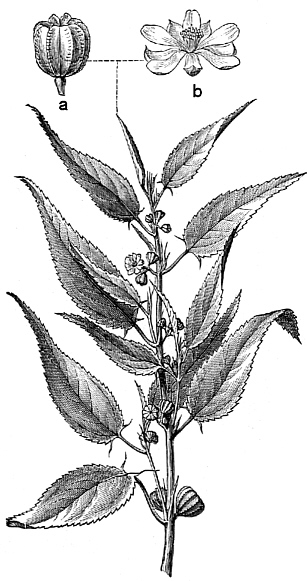

Zitierweise / cite as:
Carakasaṃhitā: Ausgewählte Texte aus der Carakasaṃhitā / übersetzt und erläutert von Alois Payer <1944 - >. -- Anhang A: Pflanzenbeschreibungen. -- Corchorus capsularis L. -- Fassung vom 2007-07-27. -- URL: http://www.payer.de/ayurveda/pflanzen/corchorus_capsularis.htm
Erstmals publiziert: 2007-07-27
Überarbeitungen:
Anlass: Lehrveranstaltung SS 2007
©opyright: Dieser Text steht der Allgemeinheit zur Verfügung. Eine Verwertung in Publikationen, die über übliche Zitate hinausgeht, bedarf der ausdrücklichen Genehmigung des Verfassers
Dieser Text ist Teil der Abteilung Sanskrit von Tüpfli's Global Village Library
WARNUNG: dies ist der Versuch einer
Übersetzung und Interpretation eines altindischen Textes. Es ist keine
medizinische Anleitung. Vor dem Gebrauch aller hier genannten Heilmittel wird
darum ausdrücklich gewarnt. Nur ein erfahrener, gut ausgebildeter ayurvedischer
Arzt kann Verschreibungen und Behandlungen machen!
Falls Sie die diakritischen Zeichen nicht dargestellt bekommen, installieren Sie eine Schrift mit Diakritika wie z.B. Tahoma.
Verwendete und zitierte Werke siehe: http://www.payer.de/ayurveda/caraka0001.htm

Abb.: Corchorus capsularis L. - Rundkapsel-Jute
[Bildquelle: Wikipedia]
Drury:
"Corchorus capsularis (Linn.) N. O. Tiliaceae Capsular Corchorus, Eng. Ghinalita pat, Beng.
Description.—Annual, 6-10 feet; calyx deeply 5-cleft; petals 5; leaves alternate, oblong-acuminate, serrated, two lower serratures terminating in narrow filaments; peduncles short; flowers whitish-yellow in clusters opposite the leaves; capsules globose, truncated, wrinkled and muricated, 5-celled; seeds few in each cell, without transverse partitions; in addition to the 5 partite cells there are other 5 alternating, smaller and empty. Fl. June—July.— W. & A. Prod. i. 73. — Wight Icon. t. 311.—Roxb. Flor. Ind. ii. 581.—Peninsula. Bengal. Cultivated.
Economic Uses.—Extensively cultivated for the sake of its fibres, especially in Bengal. The present species may be distinguished from all others by the capsules being globular instead of cylindrical The cultivation and manufacture has been described in the excellent work of Dr Royle on the Fibrous Plants of India. According to his statement, the seeds are sown in April or May, when there is a probability of a small quantity of rain. In July or August the flowers have passed. When the plants are ripe, they being then from 3 to 12 feet in height, they are cut down close to the roots, when the tops are clipped off, and fifty or a hundred are tied together. Several of these bundles are placed in shallow water, with pressure above to cause them to sink. In this position they remain eight or ten days. When the bark separates, and the stalk and fibres become softened, they are taken up and untied; they are then broken off two feet from the bottom, the bark is held in both hands, and the stalks are taken off. The fibres are then exposed to the sun to be dried, and after being cleaned are considered fit for the market These fibres are soft and silky, and may be used 'as. a substitute for flax; but although the plant is one of rapid growth and easy culture, the fibres are very perishable, and it is owing to this circumstance that they lose much of their value. The attention of practical men has been turned to remedy so serious a defect in one of the most useful products of Bengal. Could the fibres be prepared without the lengthened immersion in water, whereby they are subsequently liable to rot and decay, the difficulty might be partially if not wholly overcome. So careful is the manufacturer obliged to be, that during the time the plants are in the water, he is forced to examine them daily in order to guard against undue decomposition; and even after they are removed from the water, the lower part of the stem nearest the root, which the hand has previously held, are so contaminated that they are cut off as useless. These fragments, however, in themselves have their use: they are shipped off to America from Calcutta for the use of paper-making, preparing bags, and suchlike purposes, and even made into whisky. The great care of watching the immersed Jute until it almost putrefies, is to preserve the fine silky character so much valued in fibres intended for export. For consumption in this country such care is not taken, therefore the article is stronger and more durable. The trade is very considerable. Besides the gunny-bags made from the fibrous part or bark, the stems of the plant themselves are used for charcoal, for gunpowder, fences, basket-work, fuel.—Royle."
[Quelle: Drury, Heber <1819 - 1872>: The useful plants of India : with notices of their chief value in commerce, medicine, and the arts. -- 2d ed. with additions and corrections. London : Allen, 1873. -- xvi, 512 p. ; 22 cm. -- s.v.]